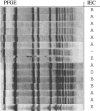The innate immune modulators staphylococcal complement inhibitor and chemotaxis inhibitory protein of Staphylococcus aureus are located on beta-hemolysin-converting bacteriophages
- PMID: 16452413
- PMCID: PMC1367213
- DOI: 10.1128/JB.188.4.1310-1315.2006
The innate immune modulators staphylococcal complement inhibitor and chemotaxis inhibitory protein of Staphylococcus aureus are located on beta-hemolysin-converting bacteriophages
Abstract
Two newly discovered immune modulators, chemotaxis inhibitory protein of Staphylococcus aureus (CHIPS) and staphylococcal complement inhibitor (SCIN), cluster on the conserved 3' end of beta-hemolysin (hlb)-converting bacteriophages (betaC-phis). Since these betaC-phis also carry the genes for the immune evasion molecules staphylokinase (sak) and enterotoxin A (sea), this 8-kb region at the 3' end of betaC-phi represents an innate immune evasion cluster (IEC). By PCR and Southern analyses of 85 clinical Staphylococcus aureus strains and 5 classical laboratory strains, we show that 90% of S. aureus strains carry a betaC-phi with an IEC. Seven IEC variants were discovered, carrying different combinations of chp, sak, or sea (or sep), always in the same 5'-to-3' orientation and on the 3' end of a betaC-phi. From most IEC variants we could isolate active bacteriophages by mitomycin C treatment, of which lysogens were generated in S. aureus R5 (broad phage host). All IEC-carrying bacteriophages integrated into hlb, as was measured by Southern blotting of R5 lysogens. Large quantities of the different bacteriophages were obtained by mitomycin C treatment of the lysogens, and bacteriophages were collected and used to reinfect all lysogenic R5 strains. In total, five lytic families were found. Furthermore, phage DNA was isolated and digested with EcoR1, revealing that one IEC variant can be found on different betaI-phis. In conclusion, the four human-specific innate immune modulators SCIN, CHIPS, SAK, and SEA form an IEC that is easily transferred among S. aureus strains by a diverse group of beta-hemolysin-converting bacteriophages.
Figures




References
-
- Baba, T., F. Takeuchi, M. Kuroda, H. Yuzawa, K. Aoki, A. Oguchi, Y. Nagai, N. Iwama, K. Asano, T. Naimi, H. Kuroda, L. Cui, K. Yamamoto, and K. Hiramatsu. 2002. Genome and virulence determinants of high virulence community-acquired MRSA. Lancet 359:1819-1827. - PubMed
-
- Carroll, J. D., M. T. Cafferkey, and D. C. Coleman. 1993. Serotype F double-converting and triple-converting phage insertionally inactivate the Staphylococcus aureus beta-toxin determinant by a common molecular mechanism. FEMS Microbiol. Lett. 106:147-155. - PubMed
-
- Coleman, D., J. Knights, R. Russell, D. Shanley, T. H. Birkbeck, G. Dougan, and I. Charles. 1991. Insertional inactivation of the Staphylococcus aureus beta-toxin by bacteriophage phi 13 occurs by site- and orientation-specific integration of the phi 13 genome. Mol. Microbiol. 5:933-939. - PubMed
-
- Coleman, D. C., J. P. Arbuthnott, H. M. Pomeroy, and T. H. Birkbeck. 1986. Cloning and expression in Escherichia coli and Staphylococcus aureus of the beta-lysin determinant from Staphylococcus aureus: evidence that bacteriophage conversion of beta-lysin activity is caused by insertional inactivation of the beta-lysin determinant. Microb. Pathog. 1:549-564. - PubMed
-
- Coleman, D. C., D. J. Sullivan, R. J. Russell, J. P. Arbuthnott, B. F. Carey, and H. M. Pomeroy. 1989. Staphylococcus aureus bacteriophages mediating the simultaneous lysogenic conversion of beta-lysin, staphylokinase and enterotoxin A: molecular mechanism of triple conversion. J. Gen. Microbiol. 135:1679-1697. - PubMed
MeSH terms
Substances
LinkOut - more resources
Full Text Sources
Other Literature Sources
Molecular Biology Databases

